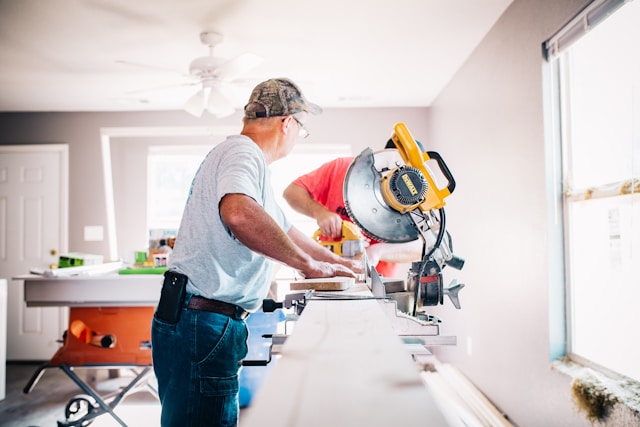
Home repairs are a necessary aspect of homeownership, and the allure of DIY work can be strong, especially when considering the potential cost savings. However, the reality of undertaking home repairs without professional help can often lead to unexpected challenges and risks. In New Jersey, where homes vary widely from coastal cottages to urban dwellings, the specific demands and conditions affecting these structures make professional oversight crucial in many cases. Understanding when to hire a professional can save not only money but also ensure the safety and longevity of your home. In this blog, we will share reasons why DIY repairs might not always be the best choice.
1. Lack of Expertise
The first major risk with DIY home repairs is the lack of professional expertise. Many homeowners are not trained to identify structural issues or understand complex systems within their homes. Mistakes in assessing the severity of problems can lead to inadequate repairs that may not only fail to solve the issue but also cause further damage. Without the correct knowledge, what begins as a minor fix can quickly escalate into a costly disaster.
2. Safety Hazards
DIY repairs often involve risks that can lead to personal injury or create additional safety hazards in the home. Tasks like electrical wiring or structural modifications require precise skills and knowledge to execute safely. Without proper training and equipment, homeowners expose themselves to significant risk of accidents, which can result in severe injuries or even life-threatening situations.
3. Compromised Roof Repairs
Roof repairs are particularly hazardous and complex, requiring a clear understanding of materials and techniques to avoid compromising the structure. This is a task where the expertise of a roofing company in New Jersey is invaluable. They are equipped to handle the intricacies of roof work, ensuring that repairs are performed safely and effectively, mitigating the risk of leaks and water damage that can stem from improper DIY repairs.
4. Voiding Warranties
Another pitfall of DIY repairs is the potential to void warranties on critical components of your home. Many manufacturers require that a certified professional perform repairs and maintenance to keep warranty protections in place. DIY interventions on elements like your furnace, roof, or windows could void these warranties, potentially leading to significant out-of-pocket costs for replacements that would otherwise have been covered.
5. Overlooking Underlying Issues
DIY repairs often treat the symptoms of a problem rather than its root cause. Homeowners may fix a leaky faucet but overlook the underlying plumbing issues causing the leak. This can lead to recurring problems and increased damage over time, as the actual cause continues to deteriorate the home’s infrastructure unnoticed.
6. Increased Costs
While DIY projects are often initiated to save money, they can ironically end up being more expensive than hiring professionals from the start. Incorrect methods, temporary fixes, or damage from failed repair attempts can all lead to higher costs in the long run. Professionals can often get the job done right the first time, avoiding the cascade of costs associated with correcting DIY mistakes.
7. Time Consumption
DIY home repairs often take much longer than expected, especially for those without extensive experience. Homeowners may find that what was anticipated as a weekend project extends over several weekends or even longer, disrupting daily life. This not only delays the resolution of the issue but also takes away valuable time that could be spent with family or on other activities. The efficiency of hiring a professional, who can complete the same task in a fraction of the time, can significantly reduce stress and inconvenience.
8. Improper Tool Use
Using the right tools is critical for any home repair project, and improper use can lead to damage both to the tool and the home. Many homeowners do not have access to the specialized tools required for certain repairs, leading to improvised solutions that may not be effective or safe. This not only risks injuring the DIYer but also can result in a poorly executed job that may need to be redone by a professional later.
9. Potential for Incorrect Installations
Incorrect installation of home components can have serious repercussions. For example, improperly installed plumbing can lead to leaks, water damage, and costly repairs. Electrical fixtures installed incorrectly pose a risk of fire. Without proper knowledge and techniques, DIY repairs can create issues that might not become apparent until they result in significant damage or require expensive remediation.
10. Regulatory and Code Violations
Many homeowners are unaware of local building codes and regulations that govern home renovations and repairs. DIY projects that do not comply with these regulations can lead to fines and may require costly adjustments to meet legal standards. Professional contractors are familiar with these codes and can ensure that all work is compliant, avoiding legal headaches and ensuring that the home meets safety standards.
Conclusion
While the appeal of saving money through DIY home repairs is understandable, the potential risks and costs associated can often outweigh these initial savings. Homeowners should carefully consider the scope of any repair project, evaluating whether they have the skills, tools, and understanding necessary to complete it successfully. For many, particularly when it comes to significant or safety-critical tasks, investing in professional services is not just a matter of convenience but of ensuring quality, safety, and peace of mind. This approach not only protects the home’s value but also ensures it remains a safe and enjoyable place to live.